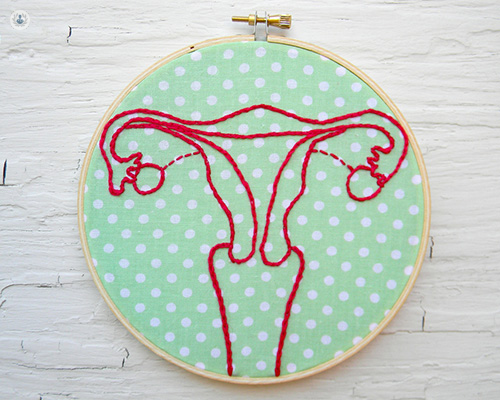What is endometrial cancer?
Endometrial cancer begins in the layer of the cells that form the lining of the uterus, which is the organ where foetal development (reproduction) occurs. It is sometimes known as uterine cancer. Endometrial cancer is usually detected early because it produces abnormal vaginal bleeding.
Currently, the exact cause is not known but it may be related to increased levels of oestrogen. If detected in the early stages, the removal of the uterus often cures the disease.

What are the symptoms of endometrial cancer?
The symptoms present in endometrial cancer are abnormal vaginal bleeding after menopause, lower abdominal pain or cramping in the pelvis, and white vaginal discharge.
What are the risk factors for endometrial cancer?
As it is not clear what causes endometrial cancer, there are certain risk factors that can increase the chances of developing it. These include:
- High levels of the hormone oestrogen, which can be caused by obesity
- Never having been pregnant
- Older age
- Hormone therapy for breast cancer
- Having started menstruation at an early age
How can endometrial cancer be prevented?
The risks of endometrial cancer can be reduced if you keep your body weight in a normal healthy range, discuss the risk of hormone replacement therapy (HRT) after menopause with your doctor, and consider taking birth control pills.
How is endometrial cancer treated?
Endometrial cancer is most commonly treated with removal of the womb (hysterectomy). In the early stages of the disease, the procedure can cure womb cancer, however, it means that you will not be able to get pregnant in the future. Radiotherapy and chemotherapy are also given too.
For women who are younger and who would still like to have children, a type of hormone therapy (progestogen) is an option, which lowers the hormone levels in the body.
Endometrial cancer
Mr Rahul Nath - Obstetrics & gynaecology
Created on: 09-21-2015
Updated on: 07-27-2023
Edited by: Conor Lynch
What is endometrial cancer?
Endometrial cancer begins in the layer of the cells that form the lining of the uterus, which is the organ where foetal development (reproduction) occurs. It is sometimes known as uterine cancer. Endometrial cancer is usually detected early because it produces abnormal vaginal bleeding.
Currently, the exact cause is not known but it may be related to increased levels of oestrogen. If detected in the early stages, the removal of the uterus often cures the disease.

What are the symptoms of endometrial cancer?
The symptoms present in endometrial cancer are abnormal vaginal bleeding after menopause, lower abdominal pain or cramping in the pelvis, and white vaginal discharge.
What are the risk factors for endometrial cancer?
As it is not clear what causes endometrial cancer, there are certain risk factors that can increase the chances of developing it. These include:
- High levels of the hormone oestrogen, which can be caused by obesity
- Never having been pregnant
- Older age
- Hormone therapy for breast cancer
- Having started menstruation at an early age
How can endometrial cancer be prevented?
The risks of endometrial cancer can be reduced if you keep your body weight in a normal healthy range, discuss the risk of hormone replacement therapy (HRT) after menopause with your doctor, and consider taking birth control pills.
How is endometrial cancer treated?
Endometrial cancer is most commonly treated with removal of the womb (hysterectomy). In the early stages of the disease, the procedure can cure womb cancer, however, it means that you will not be able to get pregnant in the future. Radiotherapy and chemotherapy are also given too.
For women who are younger and who would still like to have children, a type of hormone therapy (progestogen) is an option, which lowers the hormone levels in the body.


Ask an expert: What are the symptoms of endometrial cancer?
By Dr Natalia Povolotskaya
2024-11-18
In the UK, more than 9,000 people are diagnosed each year with endometrial cancer of the reproductive system. Here, Dr Natalia Povolotskaya, leading consultant gynaecologist and cancer surgeon, provides an expert insight into endometrial cancer, including risk factors, symptoms, and treatment. See more


A comprehensive overview of endometrial hyperplasia
By Mr Osama Naji
2024-11-15
In this article, find out what endometrial hyperplasia is, and what the related symptoms and causes are, as esteemed consultant gynaecologist, Mr Osama Naji, provides us with an all-you-need-to-know guide. See more


Endometrial cancer: advanced stages and targeted treatment
By Professor Susana Banerjee
2024-11-11
Endometrial cancer, also known as uterine or womb cancer, is a cancer of the uterus that is formed by abnormal cell growth inside the tissue of the womb, called the endometrium. In its later stages, it can be difficult to treat, but targeted therapies may be able to provide new hope for patients in their fight against the cancer. In this article, a leading medical oncologist explains the stages of endometrial cancer and how targeted treatment can be used against it. See more
Experts in Endometrial cancer
-
Mr Rahul Nath
Obstetrics & gynaecologyExpert in:
- Robotic surgery
- Abnormal smear test
- Cervical cancer
- Endometrial cancer
- Human papillomavirus (HPV)
- Ovarian cancer
-
Professor Susana Banerjee
Medical oncologyExpert in:
- Ovarian cancer
- Endometrial cancer
- Cervical cancer
- Gynaecological cancer
- BRCA gene
- Clinical trials
-
Dr Angela George
Medical oncologyExpert in:
- Ovarian cancer
- Endometrial cancer
- Chemotherapy
- Immunotherapy
- Genetics of cancer
- Genetic counselling
-
Miss Nahid Gul
Obstetrics & gynaecologyExpert in:
- Endometrial cancer
- Endometriosis
- Pelvic pain
- Robotic surgery
- Pelvic floor reconstructive surgery
- Colposcopy
-
Mr Auos Al-Dujaily
Obstetrics & gynaecologyExpert in:
- Pelvic pain
- Menstrual disorders
- Ovarian cancer
- Endometrial cancer
- Ovarian cyst
- Menopause
- See all

The Lister Hospital - part of HCA Healthcare
The Lister Hospital - part of HCA Healthcare
Chelsea Bridge Road, London
No existe teléfono en el centro.
By using the telephone number provided by TOP DOCTORS, you automatically agree to let us use your phone number for statistical and commercial purposes. For further information, read our Privacy Policy
Top Doctors

Leaders in Oncology Care (LOC) - part of HCA Healthcare
Leaders in Oncology Care (LOC) - part of HCA Healthcare
95-97 Harley St, London
No existe teléfono en el centro.
By using the telephone number provided by TOP DOCTORS, you automatically agree to let us use your phone number for statistical and commercial purposes. For further information, read our Privacy Policy
Top Doctors

The Portland Hospital - part of HCA Healthcare
The Portland Hospital - part of HCA Healthcare
205 - 209 Great Portland St. W1W 5AH
No existe teléfono en el centro.
By using the telephone number provided by TOP DOCTORS, you automatically agree to let us use your phone number for statistical and commercial purposes. For further information, read our Privacy Policy
Top Doctors
-
The Lister Hospital - part of HCA Healthcare
Chelsea Bridge Road, London , Central LondonExpert in:
- Cancer
- Cardiology
- Orthopaedic surgery
- Pregnancy
- Physiotherapy
- Women’s health
-
Leaders in Oncology Care (LOC) - part of HCA Healthcare
95-97 Harley St, London, Central LondonExpert in:
- Cancer
- Breast Cancer
- Prostate Cancer
- Kidney Cancer
- Haemato-oncology
- Medical Oncology
-
The Portland Hospital - part of HCA Healthcare
205 - 209 Great Portland St. W1W 5AH, Central LondonExpert in:
- Neurological spinal surgery
- Orthopaedic spinal surgery
- Maternity care
- Pregnancy
- Scoliosis
- In vitro fertilisation (IVF)
- See all
- Most viewed diseases, medical tests, and treatments
- CAR-T cells
- Menopause support
- Hormone therapy
- Pelvic ultrasound
- Complex endometriosis
- Maternal mental health
- Genetic testing
- Nipple discharge
- Minimal access surgery (keyhole surgery)
- Head and neck cancer







